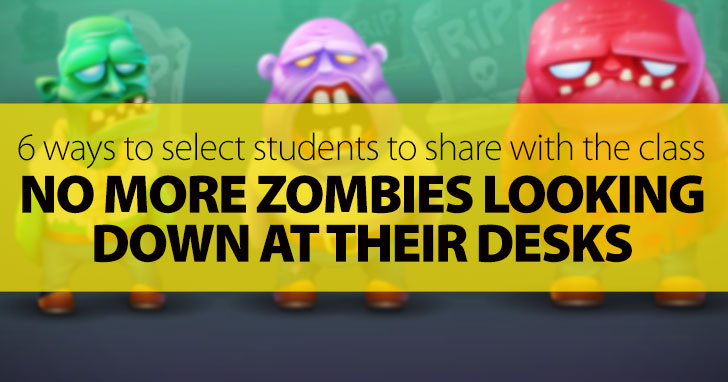“Does That Make Sense?” Ways To Check For Comprehension


Another variation is the class with one or two eager students backed by a full choir of zombies waving in the background. Usually this results in teachers simply selecting random students to answer questions or present next. The problem is that by calling on students at random, the teacher only reinforces the students’ desire to remain out of sight. There is little incentive for students to volunteer or engage in class. Indeed, it can actually increase student apathy as there is a sense that ‘no matter what, the teacher will choose whomever he/ she wants,’ or ‘the teacher is always picking on me.’ At the end of the day, it can even make the teacher look like the ‘bad guy.’ On that note, here are a few techniques to select students to share without putting yourself directly in the line of fire. Some of them even come with built-in incentives to volunteer.

Depending on the school/region you are teaching in, your students may well have been assigned numbers. In Korea, all students within a given class are numbered 1-40 (or something to that effect). If you teach more than ten classes, it is very unlikely that you will know which of these numbers is associated with which student. Your students will be aware of this as well, although it never hurts to play it up a bit to remind them. When necessary, simply call out a number that fits in the range for the class. An effective way to use these numbers in an even more random way is to have a list of them on a piece of paper. After you call for volunteers and get the blank stares, simply drop a pen, eraser, whatever on this paper. Call out the number it lands on and that student, or the group that the student is in, goes next. Although this does little to provide incentive for students to volunteer, it certainly removes the idea that the teacher is picking on any one student.
This is one of my favourites, and it’s great because it’s relatively simple. Whoever volunteers gets to pick the next student or group to speak. There are a couple of variations that allow teachers to adapt this to their own preference. One choice that teachers must make is if they will require the students to actually volunteer to qualify for selecting the next person. So, if there are no volunteers, thus forcing the teacher to select someone to go first, does that student get to choose the second presenter, or do they only get that privilege if they actually volunteered to go first? I tend to take the latter course, as it has the added benefit of actually providing a bit of incentive for students or groups to volunteer.
Many schools use computer programs that include student lists, allowing teachers to easily update student participation records. Often these come with a built in random selection mechanism. If your school does not use one of these programs, there are several available for free online. One that jumps to mind is class dojo. While I can’t speak for the technical side of the programs that are available out there, applying them in the classroom is pretty easy. When volunteers are not forthcoming, hit the random select application and see who pops up. Then either they or their group are up next. From here, teachers can implement the volunteer-selects-the-next-person idea, seeing as the ball will already be rolling.
This method tends to work best in elementary schools, but it has been used with some success at higher levels. All you need is a ball, or some other relatively non-invasive item, that the students can pass rapidly from hand-to-hand. Set a timer for thirty seconds, or whatever seems appropriate given your class size, and have the students start passing the ball around. Whoever is holding it when the timer ends has to respond to the question or present first. An alternative is simply have the students pass the ball while the teacher faces the board. The teacher then calls ‘stop’ and whoever has the ball at that time must respond. The problem with this is the teacher is not watching and therefore can’t monitor the behaviour of the students when they are passing the ball.
Hand out popsicle sticks to the students and have them write their names on the sticks. Alternatively, the teacher can write the names on the popsicle sticks, but given that some teachers have close to a thousand students with names in a foreign language, this could be a little daunting. Once the names are on the popsicle sticks, place them all a box, tub, cup, etc. and then, whenever participation is a little lax, simply draw a stick. That student must then respond. If students complain that you are not being fair, let one of them draw the stick. Once again, it might be useful to ask the student who has just shared to draw the next stick.
This is selection technique is based on the colour of clothing that students are wearing. Teacher call out something along the lines of ‘anyone with green on their socks, please stand up’ and these students must then respond. Although the concept is very simple, teachers should be cautious that they are not creating overly large groups. For example, asking for students with blue on their pants can result in everyone in jeans (half the class) standing up. Also, it is generally best to talk about smaller items of clothing, not sweatshirts, or students may complain that it is not truly random. Of course, this method is of limited use in a school that requires uniforms.
When students get the sense that it’s a bit of a game or that selection is dependent on random chance, their interest tends to be piqued before they are even required to respond to anything. We can all call on students and try to force them to respond, but why not introduce a new system and see what happens?